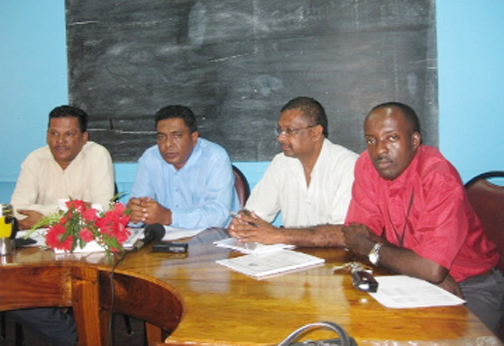Despite the current El Niño conditions, farmers in Region Six are enjoying adequate water for their crops as the Regional Democratic Council (RDC) is “working around the clock” on the drainage and irrigation (D&I) systems.

At a press conference at the regional boardroom on Thursday, Regional Chairman Zulfikar Mustapha said the region had spent additional sums amounting to $500M and used its five excavators to provide a better service. As a result, farmers in the region are presently cultivating 46,280 acres of rice. He said the farmers at Black Bush Polder and No. 52 to 74 Villages are receiving “gravity flow of water” and had even requested that the pump at Manarabisi be turned off. He pointed out that 18,000 acres of rice land is available for cultivation at Black Bush Polder, 17,500 acres at No. 52 to 74 Villages and 3,500 acres at Crabwood Creek.
There has also been an increase of 22,000 acres of land being cultivated from No. 52 Village to Bloomfield.
Mustapha also reported that an excavator is currently clearing land at New Forest, East Canje and this year close to 2,000 acres of rice would be cultivated there and almost 1,500 acres on the East Bank of Berbice. Referring to the 2010 budget, he said the region would have the “biggest spending” of $102M for D&I. The figure covers the excavation of an independent channel for the Johanna, Black Bush Polder area, which would run “through Johanna and between No. 36 and Bengal Village right out to the Atlantic.”
The facade for No. 52 to 74 Villages, which leads from No. 66 to No. 70 Village, would also be excavated. Double door sluices would be constructed at Light Town, East Bank Berbice-which according to the chairman is a “problematic area”-and at Kothbrat, while other sluices and pump stations along the Corentyne would be repaired. A timber revetment would also be built at Liverpool and Tain and where there are problems with erosion and at Adventure and Killmornack on the Corentyne and Mara, East Bank Berbice. Residents at Talorgie would also benefit from a new drainage structure.
The water regulators at Black Bush Polder would also be repaired at a cost of $8M, in order for the region to have better management of the water system. The regulators would also help during the rainy season to keep water in the backlands away from the residential areas and to control the flow of irrigation water into the system, according to Mustapha.
He pointed out that a major project-under a special programme titled “Agriculture Support Services Programme”-is being undertaken at Crabwood Creek. Two other projects would be done at the No. 52 to 74 Villages and in a month’s time a project to the tune of $500M would be started at Black Bush Polder.
Increase in
budget
The chairman noted that there has been an increase in the budgetary allocation in almost all of the sectors for the capital work programme. This year $27M would be spent on bridges and residents of Black Bush Polder, Crabwood Creek, Suzannah and other areas on the Corentyne would benefit from eight new heavy-duty bridges.
Last year, Mustapha said $180M was allocated for 39 additional community roads under a special project by the Office of the President through the Ministry of Finance. The region also spent $31M to assist the NDCs to maintain roads across the region. Almost 10 streets, in areas such as Goed Bananen Land, Canefield and Palmyra at Canje and Fyrish, Bloomfield, Limlair, Letter Kenny and Babu John on the Corentye as well as recently developed housing schemes, would also be rehabilitated under the capital work programme.
Recently workers of the Albion Estate protested the condition of the access road and the chairman said a contract has been awarded at a cost of $69.8M to fix it.
President Bharrat Jagdeo had announced recently that US$6M each would be spent on the 22-mile long Black Bush Polder road from Adventure to No. 43 Village and on the West Canje road. According to Mustapha the regional engineer and officials from the Ministry of Finance went around the region on Wednesday to identify other road works and may allocate a substantial sum for that purpose. In the education sector, $37M was allocated for projects such as the construction of a new nursery school at Port Mourant. Extensions would be done to the Corentyne Comprehensive, Winifred Gaskin, Manchester and the New Amsterdam secondary schools as well as to the Kildonan Primary. The practical instruction centre in New Amsterdam would also be rehabilitated.
In the health sector, $10M would be spent on projects, including the rehabilitation of the Baracara Health Centre in the Canje Creek and the extension of the drugs bond at the New Amsterdam Hospital.
The region is also hoping to place a permanent medex at the health centre so residents can benefit from continuous treatment instead of only from the monthly medical outreaches. A new boat and engine would also be purchased for medical workers to have easy access to the health facility.
Asked about the Regional Tender Board, in light of a recent problem in Region Four, Mustapha said his region does not have any problems with the tender as they “follow the system of the procurement act; the tender board works according to the rules.” He noted, however that three REOs have left the region within a short time because of alleged corruption.
He said the board consists of a chairman, secretary and representatives from the RDC, the finance and sub-treasury departments.
